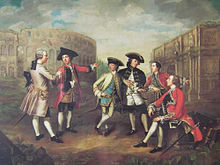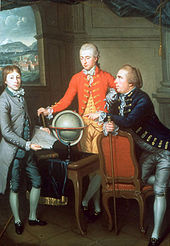Grand Tour
This is the sighted version that was marked on May 28, 2021. There is 1 pending change that needs to be sighted.
![]()
The title of this article is ambiguous. For other meanings, see Grand Tour (disambiguation).
Grand Tour [gʀɑ̃ˈtuːʀ] (French; German "große Reise"), also Kavalierstour or Cavaliersreise, was the designation for an obligatory journey, since the Renaissance, of the sons of the European nobility, later also of the upper middle classes, through Central Europe, Italy, Spain and also to the Holy Land. In a broader sense, the educational journeys of adult members of the aforementioned classes were also referred to in this way. In England in particular, the Grand Tour found a rich literary expression in the 18th century.

British connaisseurs in Rome, painting by James Russel, ca. 1750
_-_Ancient_Rome_-_Google_Art_Project.jpg)
Picture Gallery of Ancient Rome, painting by Giovanni Paolo Pannini, 1757
Targets
The Grand Tour originally represented the conclusion of education; it was intended to put the "finishing touches" to the traveller's education. In particular, the aristocrats visited important European cities to see monuments from antiquity, the Middle Ages and the Renaissance; they travelled through picturesque landscapes, but also visited European royal courts. In doing so, they were to get to know the culture and customs of foreign countries, gather new impressions and make useful connections for their future lives. Furthermore, the tour served to deepen language skills as well as to refine manners; in general, the acquisition of cosmopolitanism, status and prestige. For noble travellers in particular, it was also attractive to take lessons from French or Italian fencing masters and thereby deepen their knowledge of the craft of arms. Another unspoken goal was often the acquisition of a certain experience in erotic matters, sometimes also the initiation of marriage opportunities.
Older travellers often had other motives in addition to deepening their education and broadening their horizons. Sometimes they hoped that the milder climate of the European south would cure or alleviate illnesses, such as the poet John Keats, who travelled to Italy in 1820. Others, on the other hand, exchanged ideas with colleagues in their profession in foreign countries or carried out a wide range of research. The botanist John Ray, for example, aimed to compile a comprehensive list of foreign plants during his continental tour in the 1660s, while the baroque painter Jonathan Richardson wanted to create nothing less than a "complete catalogue of all existing statues and paintings" in Holland and Italy at the beginning of the 18th century. Frequently the Grand Tours were also used to purchase works of art, for example by Thomas Howard, 21st Earl of Arundel.
Although most of the travellers on the Grand Tour were men, there were also a few ladies, such as Mariana Starke (1762-1838) or Lady Morgan Sidney Owenson (1776-1859).
History
Visiting ancient sites in Italy had already been a tradition in circles of artists and intellectuals since the late Middle Ages. However, the Grand Tour did not really take off until the end of the 17th century, when it became fashionable among the English nobility to send their offspring on an educational trip to the continent lasting several years, comparable to a rite of passage. It began during the reign of Queen Elizabeth I of England in the 16th century. The young men between the ages of 17 and 21, usually accompanied by a tutor and financially generously supported by the family, set out for the continent and Europe to broaden their horizons, to visit ancient buildings and monuments, but also to be introduced to the high school of diplomacy. They mainly stopped at the homes of relatives, and not a few of them used this opportunity to successfully look for a bride. This great fashion from England soon found favour in other countries.
In the course of the 17th and 18th centuries, the social circle of travellers expanded to include the middle classes. A bourgeois Englishman who had wealth undertook at least a short journey to the mainland. Similar to today's travel guides, Grand Tour guidebooks and travel diaries provided recommendations on the route to take, discussed sights, customs, necessary clothing, apothecary, and reading, and noted important phrases and vocabulary of foreign languages for assistance. On the spot, travel and mountain guides took care of the young people, keeping personalized reference books. A separate service sector developed around the travellers.
Most of the population did not have the financial means to travel Grand Tour style. Citizens could afford to travel by horse or carriage. The mass of people, however, still walked. Travel conditions had thus hardly improved since the Middle Ages.
England's pioneering role can be explained, among other things, by the fact that after its victory over the Spanish Armada in 1588 it saw itself on the way to a position of world power - comparable only to that of Rome. Unlike the continent, it had not suffered the effects of the Thirty Years' War. In addition, the ideal of the gentleman, i.e. the educated, wealthy, but often idle-political Gentry member, could only be found there. At the same time, however, the fact that only the wealthy could afford such travel also encouraged the emergence of a distorted image of "the English" on the continent, which was to be found well into the 20th century.
The Grand Tour experienced a considerable upswing in the middle of the 18th century. In the course of the Enlightenment, interest in foreign cultures and people, their living conditions and surroundings, continued to grow. In addition, the desire to travel was aroused by reports of world travels and travel literature.
The decline of the aristocracy after the French Revolution also corresponded to that of the Grand Tour in the classical sense. In the 19th century, it was replaced by the educational journey, which pursued similar goals, but involved far less effort and was mostly in the hands of the - now often older - traveller himself.

Douglas, 8th Duke of Hamilton, on his Grand Tour with his physician Dr. John Moore and his son John. The city of Geneva can be seen in the background. Painted by Jean Preudhomme, 1774
Questions and Answers
Q: What is the Grand Tour?
A: The Grand Tour was a travel through Europe by rich young men, mostly British, between 1660 and 1840, aimed at learning about European society and art.
Q: Who participated in the Grand Tour?
A: Rich young men, mostly British, participated in the Grand Tour.
Q: What was the purpose of the Grand Tour?
A: The purpose of the Grand Tour was to learn about European society and art which could be used to help those who stayed at home.
Q: When did the Grand Tour take place?
A: The Grand Tour took place between 1660 and 1840.
Q: Was Italy a popular destination for those on the Grand Tour?
A: Yes, Italy was often the final country to visit on the Grand Tour.
Q: Who accompanied those who went on the Grand Tour?
A: Those who went on the Grand Tour were accompanied by servants and a teacher called a bear-leader.
Q: How long was the Grand Tour?
A: The length of the Grand Tour is not specified in the given text.
Search within the encyclopedia